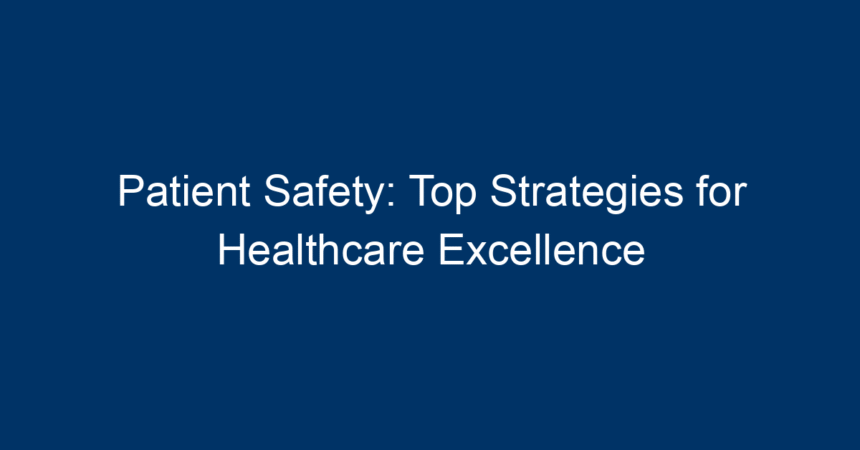In today’s multifaceted healthcare landscape, patient safety remains a paramount concern. According to the World Health Organization (WHO), patient safety is a critical global health issue, impacting millions of individuals every year. Adopting effective strategies is essential not only for compliance with regulatory requirements but also for fostering an environment of trust and care. In this article, we will delve into effective strategies for enhancing patient safety, ensuring that healthcare facilities excel in providing safe, high-quality care.
Understanding Patient Safety
What is Patient Safety?
Patient safety involves the prevention of errors and adverse effects associated with healthcare. It encompasses various practices aimed at reducing the risk of harm to patients while receiving medical care. The primary goal of patient safety is to create a zero-harm environment where patients can receive healthcare services without facing unnecessary risks.
The Importance of Patient Safety
Ensuring patient safety is fundamental for the following reasons:
- Quality of Care: Safe practices contribute to effective treatment and recovery, enhancing the overall quality of healthcare services.
- Trust: Patients are more likely to seek care when they feel safe and protected, which fosters trust in healthcare providers.
- Cost Efficiency: Preventing errors reduces the financial burden on healthcare systems by preventing costly complications, extended hospital stays, and legal disputes.
Top Strategies for Enhancing Patient Safety
1. Implementing a Culture of Safety
Establishing a culture of safety is crucial for any healthcare organization aiming for excellence. A culture of safety encourages open communication, transparency, and collaboration among staff members. Key steps to foster such a culture include:
- Encouraging Reporting: Create a non-punitive environment where employees feel comfortable reporting safety concerns or near misses.
- Regular Training: Invest in ongoing education and training for staff to ensure they are aware of best practices and emerging trends related to patient safety.
- Leadership Involvement: Leadership should actively promote safety initiatives and engage employees in discussions on safety practices.
2. Standardizing Procedures
Developing standardized procedures for various clinical practices can significantly improve patient safety. By minimizing variability in care, healthcare organizations can reduce the chances of errors. Strategies for standardization include:
- Protocols and Guidelines: Establish evidence-based protocols for high-risk procedures, medications, and patient interactions.
- Checklists: Utilize checklists for surgical procedures and medication administration to ensure that all essential steps are followed.
- Regular Audits: Conduct routine audits to assess adherence to standardized procedures and identify opportunities for improvement.
3. Utilizing Technology Effectively
The integration of technology in healthcare can enhance patient safety in numerous ways. By employing advanced tools and systems, healthcare providers can streamline processes and reduce the likelihood of errors:
- Electronic Health Records (EHR): Implementing EHR systems can provide healthcare providers with real-time access to patient information, improving the accuracy of diagnoses and treatment plans.
- Medication Management Systems: Implement automated systems for medication dispensation to minimize errors in dosage and administration.
- Telemedicine: Leverage telemedicine to ensure continuity of care while reducing the risk of infections or complications associated with in-person visits.
4. Fostering Patient Engagement
Engaging patients in their own care is crucial for enhancing patient safety. Empowering patients to take an active role in their treatment can lead to better outcomes and increased satisfaction. Key strategies for fostering patient engagement include:
- Effective Communication: Encourage open dialogue between healthcare providers and patients, ensuring that patients understand their treatment plans and any associated risks.
- Patient Education: Provide comprehensive education concerning conditions, treatments, and potential side effects to help patients make informed decisions about their care.
- Shared Decision-Making: Involve patients in decision-making processes, allowing them to express their preferences and concerns.
5. Continuous Quality Improvement (CQI)
Adopting a continuous quality improvement approach is vital for maintaining and enhancing patient safety. This strategy involves regularly assessing processes and outcomes to identify areas needing improvement. Key components of CQI include:
- Data Collection and Analysis: Implement systems to collect and analyze data related to patient outcomes, safety incidents, and performance metrics.
- Feedback Loop: Establish a feedback loop where staff can share insights about safety practices and experiences, allowing for real-time adjustments.
- Benchmarking: Measure performance against industry standards and best practices, striving to meet or exceed those benchmarks.
6. Building Interdisciplinary Teams
Healthcare delivery is a collaborative effort that requires input from various professionals. Building interdisciplinary teams fosters communication and enhances patient safety. Effective strategies for teamwork include:
- Regular Meetings: Schedule regular team meetings to discuss patient safety concerns, share updates, and align care plans.
- Role Clarity: Clearly define roles and responsibilities within the team to minimize confusion and overlap.
- Collaborative Training: Conduct joint training sessions to enhance understanding of each member’s role and the importance of teamwork in patient safety.
7. Monitoring and Reporting Adverse Events
Establishing a robust system for monitoring and reporting adverse events is essential for tracking patient safety performance. This process enables organizations to learn from mistakes and prevent recurrence:
- Incident Reporting Systems: Implement user-friendly incident reporting systems that encourage timely reporting of adverse events.
- Root Cause Analysis (RCA): Conduct thorough RCAs for significant events to understand underlying causes and guide corrective actions.
- Transparency in Reporting: Promote transparency by sharing safety data with staff and patients, fostering a culture of accountability and continuous improvement.
Conclusion: Taking Action for Patient Safety Excellence
Enhancing patient safety is an ongoing journey that requires commitment, collaboration, and a proactive approach. By implementing the strategies discussed in this article—creating a culture of safety, standardizing procedures, leveraging technology, engaging patients, focusing on continuous improvement, building interdisciplinary teams, and monitoring adverse events—healthcare organizations can significantly improve patient safety outcomes.
Actionable insights for healthcare leaders looking to make strides in patient safety include:
- Prioritize safety in organizational goals and strategic planning.
- Foster open communication among staff and between providers and patients.
- Regularly review and update safety protocols based on feedback and new evidence.
- Invest in training and development programs to keep staff informed and engaged.
By embracing these strategies and insights, healthcare organizations can not only meet regulatory requirements but also create an environment where patient safety is paramount, ultimately leading to better health outcomes and patient satisfaction.




